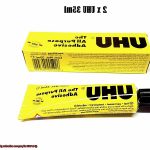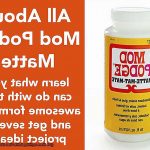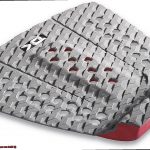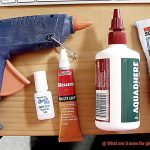Surfing isn’t just a sport; it’s a way of life.
From the moment you paddle out to catch that perfect wave, to the electrifying ride that follows, every aspect of surfing is an art form waiting to be mastered. And if you want to perfect your technique, having the right equipment is crucial.
Enter the surfboard traction pad – an often overlooked but essential component that can make all the difference in your performance. These seemingly simple pads are the unsung heroes of stability and grip, giving surfers the confidence they need to shred those waves like pros.
But have you ever stopped to wonder what these traction pads are actually made of? Well, my fellow wave riders, in this blog post we’re going to dive deep into the materials that go into creating these remarkable accessories.
Get ready to unravel the mysteries of surfboard traction pad materials.
What are surfboard traction pads?
Contents
- 1 What are surfboard traction pads?
- 2 What materials are used to make surfboard traction pads?
- 3 The Benefits of EVA Foam for Surfboard Traction Pads
- 4 Different Types of Foam Used in Surfboard Traction Pads
- 5 Additional Materials and Features Found in Surfboard Traction Pads
- 6 Installing Surfboard Traction Pads
- 7 Maintaining the Longevity of Surfboard Traction Pads
- 8 Eco-Friendly Options for Surfboard Traction Pads
- 9 Conclusion
Surfing, the epitome of adventure and freedom, demands precision, balance, and unwavering control. To maximize your performance and safety while conquering the waves, equipping yourself with the right gear is essential. Among these gears, a surfboard traction pad stands out as an indispensable accessory.
In this captivating article, we will delve into the world of surfboard traction pads—exploring their purpose, construction materials, distinctive features, and the myriad benefits they bring to surfers.

What Are Surfboard Traction Pads?
Surfboard traction pads, also known as deck grips or traction decks, are specially designed pads that offer surfers enhanced grip and stability while riding waves. Crafted from high-quality EVA foam (Ethylene-vinyl acetate), these pads are built to endure the unforgiving elements of the ocean.
Materials and Features:
- EVA Foam: The primary material used in crafting surfboard traction pads is EVA foam. Renowned for its exceptional resilience, flexibility, and lightweight properties, EVA foam guarantees outstanding shock absorption and cushioning capabilities. Moreover, its remarkable resistance to water ensures that these pads retain their functionality even in wet and salty environments.
- Texture: The secret behind superior grip lies in the textured surface of traction pads. Grooves, ridges, or dimples adorn these pads to amplify friction between the surfer’s feet and the board. This texture prevents slippage and ensures a firm grip during maneuvers and turns on the board.
- Inserts: Some traction pads incorporate strategic silicone or rubber inserts in areas requiring additional grip or support—such as the arch area or tail kick. These inserts provide unrivaled flexibility, stickiness, and increased resistance to wear, offering surfers unparalleled control over their boards.
Benefits:
- Grip and Stability: The primary purpose of surfboard traction pads is to provide surfers with a secure grip on their boards. The textured surface and high-quality EVA foam guarantee that your feet remain steadfast, significantly reducing the chances of slipping while riding waves. This, in turn, enhances stability and control.
- Comfort and Cushioning: Surfboard traction pads with thicker foam offer enhanced cushioning and comfort, ensuring that surfers can ride for extended periods without discomfort or fatigue. With these pads, you can fully immerse yourself in the thrill of surfing without worrying about sore feet.
- Durability: The high-density EVA foam used in surfboard traction pads ensures exceptional durability, preventing compression or shape deformation over time. These pads are meticulously designed to withstand the rigors of surfing, including exposure to saltwater, sunlight, and extreme temperatures.
What materials are used to make surfboard traction pads?
Surfing is all about balance, control, and riding the waves with finesse. But what keeps surfers glued to their boards, defying gravity and conquering those powerful swells? Enter the unsung heroes of the surfing world – surfboard traction pads. In this blog post, we dive deep into the materials that make up these essential pieces of surfing equipment.
EVA Foam – The Cushioning Foundation:
At the heart of every traction pad lies a resilient material known as Ethylene Vinyl Acetate (EVA) foam. This versatile material offers the perfect balance between cushioning and durability, ensuring a comfortable ride while withstanding the pounding surf. EVA foam is also water-resistant, a crucial feature for surfers who spend countless hours in the ocean.
Thermoplastic or Polyurethane (PU) Skin:
To protect the EVA foam from wear and tear, traction pads are often covered with a layer of thermoplastic or polyurethane (PU) skin. This protective layer not only enhances longevity but also adds extra grip to the surface, giving surfers an edge when it comes to maintaining control on their boards.
Embossing for Enhanced Grip:
Ever wondered how traction pads achieve that superior grip? It’s all in the texture. Through a process called embossing, raised patterns or grooves are created on the surface of the pad, providing optimal traction for surfers’ feet. So whether you’re executing sharp turns or launching off a wave, these textured surfaces ensure you stay firmly planted on your board.
Extra Features for Enhanced Performance:
Some traction pads go above and beyond by incorporating additional features such as arch support or kicktails. Arch support provides crucial comfort for long surf sessions, reducing fatigue and preventing foot strain. Kicktails, on the other hand, offer added control and leverage, allowing surfers to execute those radical maneuvers with ease.
Marine-Grade Adhesive – The Unyielding Bond:
Behind the scenes, a high-strength marine-grade adhesive works tirelessly to keep the traction pad securely attached to the surfboard. This adhesive is specially designed to withstand exposure to water, ensuring that surfers stay connected to their boards even in the most challenging conditions.
Sustainable Surfing:
As environmental awareness grows, so does the demand for sustainable surfing gear. Some manufacturers are now embracing eco-friendly alternatives, using recycled EVA foam or natural rubber in their traction pads. So you can ride the waves with peace of mind, knowing that your gear has a smaller ecological footprint.
The Benefits of EVA Foam for Surfboard Traction Pads
Surfing is more than just a sport; it’s a thrilling and liberating experience that allows you to connect with the power of nature. But if you want to ride the waves like a pro, you need the right equipment, and that includes a high-quality surfboard traction pad.
Enter EVA foam – the unsung hero of surfboard traction pads. In this article, we’ll dive deep into why EVA foam is the ultimate choice for surfers who crave superior grip, comfort, durability, versatility, eco-friendliness, and affordability.
Excellent Grip and Traction:
Picture yourself catching a wave, carving through the water with precision and grace. With an EVA foam traction pad beneath your feet, you can trust your grip to be reliable and secure. The unique texture of EVA foam provides exceptional traction, ensuring you stay firmly planted on your board even in the most challenging conditions.
Cushioning Comfort:
Surfing can be demanding on your body, especially during those long sessions. Fortunately, EVA foam cushions your feet from impact, reducing the risk of injuries and providing unparalleled comfort. Say goodbye to sore feet and hello to endless hours of pure surfing bliss.
Water-Resistant Wonder:
EVA foam is like a superhero when it comes to repelling water. Unlike other materials, it doesn’t absorb moisture, keeping your traction pad lightweight and dry throughout your entire surf session. No more waterlogged pads weighing you down.
Unyielding Durability:
When it comes to durability, EVA foam reigns supreme. Its ability to withstand saltwater, sunlight, and rough handling means your traction pad will last for multiple seasons without losing its grip or performance. That’s one less thing to worry about when you’re out there conquering those waves.
Versatile and Stylish:
Surfers are known for their unique personalities, style, and flair. With EVA foam, you have the freedom to choose a traction pad that not only performs flawlessly but also reflects your personal taste. The foam can be easily shaped and molded into various patterns and textures, allowing you to customize your board with a pad that screams “you.”
Eco-Friendly Choice:
Protecting our oceans and environment is crucial for every surfer. Luckily, EVA foam is a sustainable choice for traction pads. It’s non-toxic, recyclable, and doesn’t release harmful chemicals into the environment. Ride those waves guilt-free knowing you’re making an eco-friendly choice.
Affordable Quality:
Enhancing your surfing experience shouldn’t break the bank. Compared to alternative materials like cork or rubber, EVA foam offers a cost-effective solution without compromising on quality. Now you can enjoy the benefits of a top-notch traction pad without emptying your wallet.
Different Types of Foam Used in Surfboard Traction Pads
Surfing is more than just a sport; it’s a way of life. And every surfer knows the importance of having a reliable surfboard traction pad. But have you ever wondered what makes these pads so effective? It all comes down to the foam used in their construction.
Here, we will explore the different types of foam used in surfboard traction pads and discuss their unique characteristics and benefits.
EVA Foam: The Versatile All-Rounder
EVA foam is like the Swiss Army Knife of surfboard traction pads. It is lightweight, durable, and provides excellent grip even when wet. Whether you’re a beginner or an experienced surfer, EVA foam offers the perfect balance of cushioning and responsiveness. Plus, it comes in a wide range of colors and patterns, allowing you to express your unique style on the waves.
TPE Foam: The Feather-Like Softness
If you’re looking for a traction pad that feels like walking on clouds, TPE foam is the way to go. This material is known for its soft texture and high elasticity, conforming perfectly to the shape of your feet. TPE foam also offers excellent grip and shock absorption, making it a popular choice among surfers who value comfort above all else.
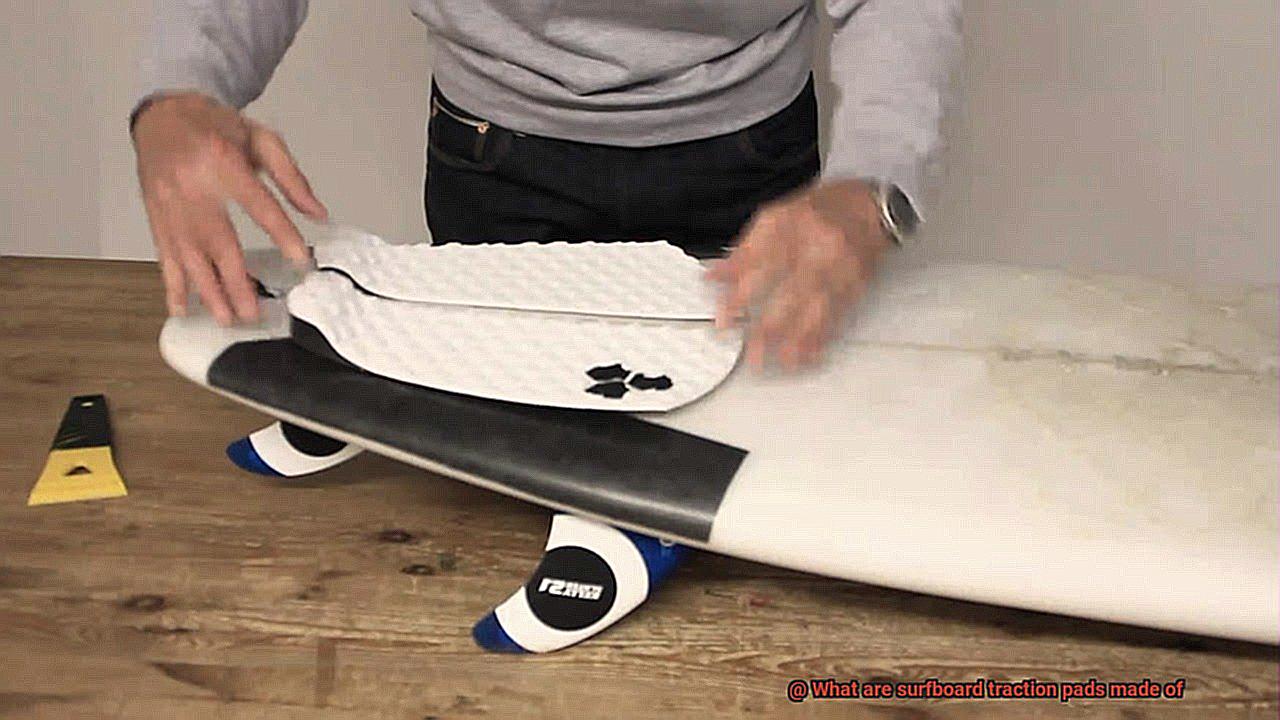
Natural Rubber Foam: The Eco-Warrior
For environmentally conscious surfers, natural rubber foam is a great option. Made from the sap of rubber trees, this biodegradable material provides outstanding grip and traction. Not only will you be riding waves with confidence, but you’ll also be reducing your carbon footprint at the same time.
Closed-Cell Foam: The Buoyant Support
Closed-cell foam is like having your personal flotation device built into your surfboard traction pad. Its sealed cells prevent water absorption, keeping your pad lightweight and preventing it from becoming waterlogged. This foam also offers excellent shock absorption and cushioning, giving you that extra layer of protection when taking on big waves.
Cross-Linked Foam: The Unbreakable Warrior
If you’re a hardcore surfer who puts their gear through the wringer, cross-linked foam is your best friend. This foam is specially designed to withstand intense surfing sessions without losing its shape or grip. It’s like having a superhero sidekick that never lets you down.
Additional Materials and Features Found in Surfboard Traction Pads
When it comes to surfboard traction pads, the goal is clear: to provide surfers with the grip and stability they need to ride waves with confidence. But did you know that there are additional materials and features incorporated into these pads that can take your surfing experience to the next level? Let’s dive in and explore the advantages of using these extra elements.
- Foam Inserts: One popular addition to traction pads is foam inserts. These offer extra cushioning and comfort for your feet, making those long surfing sessions a little easier on your soles. Imagine gliding through the water, feeling like you’re walking on clouds. Foam inserts come in various densities and thicknesses, allowing you to customize your pad to suit your preferences.
- Embedded Arch Bar: Another feature that can greatly improve your performance is an embedded arch bar. These raised sections of the pad provide support and grip for your arches, reducing foot fatigue and enhancing stability while riding waves. Arch bars are especially beneficial for surfers who spend hours in the water, as they help maintain proper foot alignment and prevent discomfort.
- Kick Tail or Kick Pad: If you’re looking to up your game when it comes to maneuvers and tricks, a kick tail or kick pad is a must-have feature. This raised section at the back of the pad gives you extra traction and control, allowing you to execute turns and aerial tricks with precision. The kick tail lets you apply more pressure on your back foot, giving you greater leverage over your board.
- Peel-and-Stick Adhesive Backing: But it’s not just about performance; durability is also key. That’s why many traction pads come with a peel-and-stick adhesive backing. This waterproof adhesive ensures that the pad stays securely in place, even in challenging conditions. Say goodbye to worrying about your pad peeling off mid-wave.
- Antimicrobial Properties: Hygiene is an important consideration for surfers who spend a lot of time in the water. That’s where antimicrobial properties come into play. Some traction pads are designed to resist the growth of bacteria and fungus, keeping your pad fresh and odor-free. This is especially important for those hot summer days when you’re sweating it out on the waves.
- Customization Options: Last but not least, customization options are available for those who want to add a personal touch to their board. With a wide range of colors and patterns to choose from, you can express your individuality and make your board stand out in the lineup. After all, surfing is all about enjoying the ride and showing off your style.
Installing Surfboard Traction Pads
Calling all wave warriors. Ready to take your surfing game to the next level? Look no further. In this comprehensive guide, we’ll walk you through the process of installing surfboard traction pads like a pro. From materials to step-by-step instructions, we’ve got you covered. So grab your board and let’s dive in.
Materials Needed:
- Surfboard traction pad
- Mild soap or surfboard cleaner
- Clean cloth
- Surfboard wax remover or rubbing alcohol (for removal)
Step 1: Prepare the Deck
Before diving in, ensure your surfboard’s deck is spotless. Use mild soap or surfboard cleaner to scrub off dirt and wax residue. A clean deck ensures optimal adhesion.
Step 2: Peel and Stick
Peel off the backing paper from each piece of the traction pad. Start from the tail end and work towards the nose. Avoid touching the adhesive surface to maintain its stickiness.
Step 3: Align and Press Firmly
Align each piece with your desired foot placement on the board. Press down firmly, ensuring a secure bond between the pad and the deck. Use a clean cloth or your hands to smooth out air bubbles or wrinkles.
Step 4: Let it Cure
Resist the temptation to hit the waves right away. Allow the adhesive to cure for at least 24 hours before using the board. This ensures a strong bond between the traction pad and the deck.
Step 5: Removal (if needed)
If you ever need to remove your traction pad, don’t worry. Gently peel back each section, starting from one end and working across. Use surfboard wax remover or rubbing alcohol to clean any adhesive residue.
Maintaining the Longevity of Surfboard Traction Pads
We understand your frustration. Don’t worry, we’ve got you covered with some valuable tips on how to take proper care of your traction pads, so they can last longer and keep you shredding those waves like a pro. From cleaning to adhesive options, let’s dive in and discover the secrets to maintaining the longevity of your surfboard traction pads.
Importance of Cleaning:
Regularly cleaning your surfboard traction pads is crucial for their longevity. After each surf session, give your pad a thorough rinse with freshwater to remove corrosive saltwater and abrasive sand. These elements can wear down the materials over time. To tackle stubborn dirt or grime, use a mild soap or surfboard cleaner. But remember, avoid harsh chemicals or abrasive scrub brushes that can damage the pad.
Removing Existing Glue:
Over time, the adhesive used to attach the traction pad may weaken, causing it to lift or peel off. When this happens, it’s essential to remove the existing glue before reapplying. Gently peel off the old pad using a plastic scraper or your fingers, being careful not to damage the board’s surface. If there’s residue left behind, use a non-acetone nail polish remover or adhesive remover to clean it up.
Best Glues for Reattaching:
Choosing the right adhesive is crucial when reattaching your traction pad. Look for marine-grade epoxy or specialized surfboard traction pad glues designed for optimal adhesion in water environments. These glues are resistant to water and provide a strong bond between the pad and board, ensuring it stays in place during intense surfing sessions.
Proper Storage:
Storing your surfboard properly is another key factor in maintaining traction pad longevity. Excessive heat and sunlight can cause materials to deteriorate more quickly. Store your board in a cool, shaded area like a garage or surfboard bag. If possible, keep the board out of direct sunlight when not in use to protect both the traction pad and the rest of the board.
Regular Inspections:
Regularly inspect your traction pad for signs of wear or damage. Weak adhesive or lifting pads should be promptly addressed by reapplying adhesive or replacing the traction pad altogether. By catching these issues early on, you can prevent further damage and extend the life of your traction pad.
Eco-Friendly Options for Surfboard Traction Pads
Are you passionate about riding the waves while minimizing your environmental impact? Look no further than eco-friendly options for surfboard traction pads. These sustainable alternatives not only provide exceptional grip but also help protect our oceans and planet.
Let’s dive into the world of eco-friendly surfboard traction pads and discover why they are worth considering.
Cork Traction Pads:
Picture yourself riding the waves with a traction pad made from cork, a natural and renewable material harvested from cork oak trees. Not only does cork offer outstanding durability and grip, but it also adds a touch of unique style to your board. By choosing cork traction pads, you’re making a sustainable choice that showcases your commitment to the environment.
Recycled Materials:
Say goodbye to waste in landfills. Some manufacturers now repurpose materials like recycled EVA foam to create traction pads. These companies are reducing their environmental footprint while still providing the necessary grip and performance. By opting for traction pads made from recycled materials, you’re actively contributing to waste reduction and sustainability.
Natural Rubber:
Derived from the sap of rubber trees, natural rubber is a sustainable resource that can be transformed into traction pads. These biodegradable and durable pads offer exceptional grip without harming the environment. Choosing natural rubber traction pads allows you to surf with peace of mind.
Algae-Based Materials:
Imagine riding the waves on a traction pad made from algae. Some companies are using algae-based materials, which are rapidly renewable resources found abundantly in water bodies. Not only do these innovative pads provide superior grip, but they also reduce reliance on non-renewable resources. By embracing this cutting-edge technology, you can surf with confidence, knowing you’re supporting sustainable practices.
Remember: Not all traction pads on the market are eco-friendly, so it’s crucial to do your research and choose brands that prioritize sustainability. By making an informed decision, you can ride the waves guilt-free and contribute to the preservation of our oceans and planet.
RZ32I5H_R98″ >
Conclusion
In conclusion, surfboard traction pads are typically made of high-quality EVA foam.
This material provides excellent grip and traction, allowing surfers to maintain control and stability on their boards. The foam is lightweight and durable, ensuring that the traction pad can withstand the rigors of surfing.
Additionally, the surface of the pad is often textured or patterned to further enhance grip. Some traction pads also feature a kick tail at the rear, providing extra leverage for maneuvers and turns.
Overall, these pads are an essential accessory for any surfer looking to maximize their performance on the waves.


